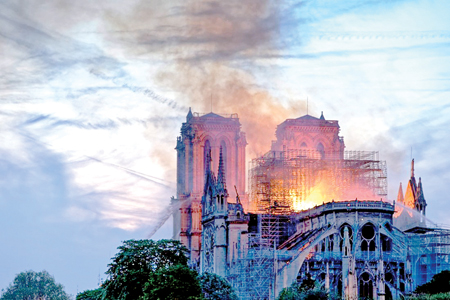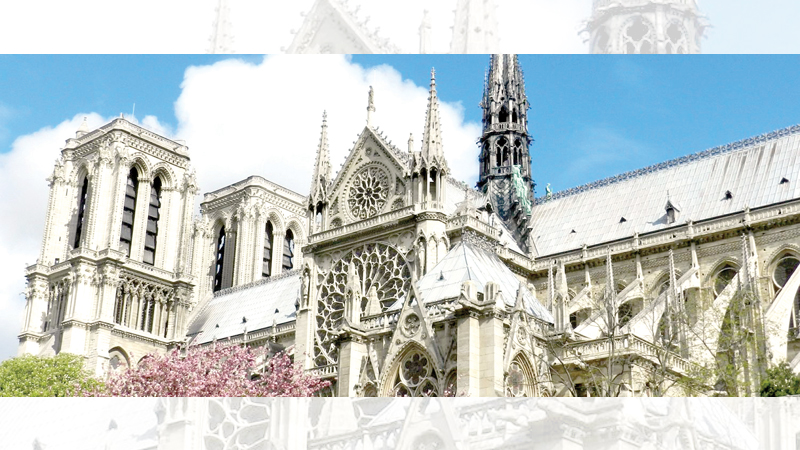 The year was 2019, the date April 15 and the time was 6.18 pm, the roof space of Notre-Dame de Paris, one of the most iconic and largest monuments in the world was engulfed in flames. The culprit was believed to be a cigarette butt on an electrical short circuit sparking a massive conflagration which devastated the wooden spire, the wooden roof and the upper walls of the medieval cathedral in the heart of the City of Lights, Paris.
The year was 2019, the date April 15 and the time was 6.18 pm, the roof space of Notre-Dame de Paris, one of the most iconic and largest monuments in the world was engulfed in flames. The culprit was believed to be a cigarette butt on an electrical short circuit sparking a massive conflagration which devastated the wooden spire, the wooden roof and the upper walls of the medieval cathedral in the heart of the City of Lights, Paris.
The vaulted stone ceilings held the disintegrating roof and prevented excessive damage to the Cathedral’s precious interior. Many precious works of art and religious antiquities were taken to safety by quick thinking staff to prevent further damage. Fast forward to December 7, 2024, five years after that fateful event, the grand cathedral was resurrected from the fire and debris and stood majestic as it had done many centuries ago.
Extent of the damage
The most disastrous damage happened to the awning and the church spire. The fire totally demolished the wooden awning, called the “forest,” which was constructed from 1,300 oak trees. The spire, a central part of the cathedral, came tumbling down with the conflagration. The fire drastically endangered the cathedral’s exquisite wooden framework causing the roof’s lead to melt.
Despite the fire being confined to the ceiling and spire, certain sections of the cathedral interior were also affected. The vaulted ceiling suffered further damage when the fire extended to portions of the nave and transepts. Many treasured objects in the cathedral, like paintings and statues, were in danger of being damaged by the smoke but were largely rescued thanks to prompt response efforts.
Some invaluable relics, like the Crown of Thorns and the tunic of Saint Louis, were rescued from the fires by diligent firefighters and the church staff. Nevertheless, many artworks and artefacts were damaged or needed extensive repair.
The irreplaceable and enchanting rose windows of the cathedral survived the smoke and fire, although some damage was inevitable. For the better part, despite the high heat, the stone construction of the Notre-Dame resisted the fire, although some stonework shattered and became fragile.
Return to its former glory
The disintegration of the iconic Notre Dame spire was the culmination of the 2019 fire. Although many perceived it to be a medieval construction, the spire was taken down, during the 1790’s supposing it to be too dangerous. This replacement was what was torched down five years ago, which belonged to a neo-Gothic reconstruction executed by architect Eugène Viollet-Le-Duc. For the reconstruction, the builders combined the use of traditional methods and computers to develop and construct the enormous wooden base. It was raised into position by the biggest crane in Europe, while a scaffolding permitted workers to assemble the steadily growing construction.
 As in the roof, the spire is lined with lead at its summit, while a new gilded cockerel positioned to substitute the original that dropped in the fire. Although it was retrieved, the cockerel had sustained damages and had to be replaced by a new one. The new one contained holy relics such as a thorn from the cathedral’s Crown of Thorns and a scroll inscribed with the names of the 2,000 people who laboured in the renovation.
As in the roof, the spire is lined with lead at its summit, while a new gilded cockerel positioned to substitute the original that dropped in the fire. Although it was retrieved, the cockerel had sustained damages and had to be replaced by a new one. The new one contained holy relics such as a thorn from the cathedral’s Crown of Thorns and a scroll inscribed with the names of the 2,000 people who laboured in the renovation.
The fire had rendered the stonework dull and full of soot; however, during reconstructions the limestone blocks were cleaned while some parts of it were completely replaced. The replacement stones were quarried from Northern France. Specialists were able to detect certain features in the authentic stone that allowed them to decide its geographical source.
The bulk of the masonry remained unharmed, but it was swathed in age-old accumulations of dust and debris from the past and layers of soot and lead powder from the fire. It was washed with high-powered vacuums and then sprayed to remove the dirt and over 40,000 square metres of stone were cleaned.
To reconstruct the vaulted canopy underneath where the spire had stood, masons had to hone in on the principles of Gothic era architecture – utilising a wooden scaffolding to place the rocks in position while crowning it all with the keystone. The wooden framework of the roof, also known as the “forest” had to be completely replaced due to the large number of oak beams getting completely ruined. To reconstruct it, professionals replicated the original design utilising traditional approaches that dated all the way back to the 12th century.
A crucial decision was made to reconstruct the roof using oak timber from French forests. Over 1,000 oak trees were felled for the restoration, a procedure that tried to honour the authentic materials utilised to construct the edifice.
There was a stipulation that the trees be straight, free from a condition called forest-crack and at least 13 metres long. The oak beams are then tediously shaped and arranged by adept craftsmen.
The renovation also involved reconstructing the ribbed vaults of the roof, which are critical for the cathedral’s structural integrity. The wood was sawn by hand and then hewed into shape with the use of axes, just like the shafts were constructed during the 13th century.
Overall, there are 35 “fermes” which are triangular arrangements that carry the weight driving the length of the construction.
Some of the most famous sculptures found in the cathedral like the Vow of Louis XIII and Virgin of the Pillar appeared unscathed and have been cleaned and provided with minor restorations. The cathedral’s multiple artworks have also been touched up such as the “Mays” – which are gigantic scenes depicting the life of Christ, donated to the Cathedral during the 17th Century by the goldsmiths of Paris
The fire provided an opportunity to rediscover the magnificence that lay buried beneath years of dirt and grime. None of the stained glass windows were affected and neither were the iconic rose windows. However, the former were dismantled, cleaned off of decades of dust and dirt and returned while the latter remained as it was. The rejuvenated limestone blocks will undoubtedly gleam beside the colourful stained glass windows of the cathedral.
The gargoyles of Notre Dame
The iconic gargoyles of Notre Dame are products of the imagination of architect Eugène Viollet-Le-Duc, and symbolise the evil that lurks in the form of ungodly forces. These bizarre animals, often depicted as hideous and terrifying, have fascinated the minds of pilgrims, authors, sightseers and residents for centuries.
The gargoyles have come to represent the strength of this iconic structure. The damage that took place were primarily due to the high-pressure hoses used to combat the fire, while the majority remained intact and solemnly observed the restoration efforts of the cathedral below. A workshop was set up in front of the cathedral to rework on the gargoyles and replace them where necessary; only five of the gargoyle statues were scanned by a computer and then re-carved on limestone.
Other renovations
The Northern tower has 8 bells of gigantic size, each of them were removed and cleaned and fixed back to recapture its former glory. The altar, lectern and seating were all destroyed during the fire, thus returning visitors will get to witness a change in the liturgical plan of the cathedral. A simple altar made of bronze will take centre stage while new cups will be used for the sacraments. The congregational gathering will sit in newly constructed wooden chairs with a new reliquary constructed to contain the sacred relics of the Crown of Thorns. Although not affected by the fire, the church’s 18th century organ with its 8,000 pipes were cleaned ahead of the monumentous first service held on December 7 since the disastrous fire on April 15 2019.
The fire had resulted in an accumulation of lead monoxide and dust, inside the organ which stands at 12 metres high with six keyboards, 19 wind chests and 7,952 pipes. The whole structure was dismantled and cleaned at workshops outside of Paris. Its leather linings were replaced and brand new electronic controls were fixed to the organ. Once the installations were complete, each organ pipe had to be re-tuned which took several months to complete.
During Pagan times the site of the church was occupied by a Gallo-Roman temple dedicated to Zeus, also known as Jupiter. The Pillar of the Boatmen, a massive Roman column with written inscriptions found beneath the cathedral in 1710 built by the guild of boatmen in honour of Jupiter, recounts the existence of this temple.
During the 4 or 5th Century, a Christian church, the Cathedral of Saint Etienne was constructed close to the site.
Façade
Its entrance was 40 metres west of the façade of present day Notre Dame and half the size of the cathedral and was around 230 feet long and divided into nave and four aisles by marble columns decorated with mosaics.
A Romanesque remodeling of Saint Etienne was the final church to have been built on the grounds where Notre Dame stood as it was believed to be unfit for the growing population of Paris.
Maurice de Sully, the Bishop of Paris, demolished the earlier cathedral in 1160 to build a much larger and grander project. The new church was to incorporate Gothic architecture which had seen the light of day in the royal abbey of Saint Dennis in the late 1130’s.
Jean de Saint Victor, a chronicler, recorded in his Memorial Historianum that construction started in 1163 between March, 24 and 25 and the foundation stone was laid before Pope Alexander III and King Louis VII.
Following the fire a global campaign was set up to help support the reconstruction efforts called the ‘Friends of the Notre Dame’. According to a CNN report over $ 900 million was raised with donors ranging in numbers to at least 340,000 from 150 countries.







